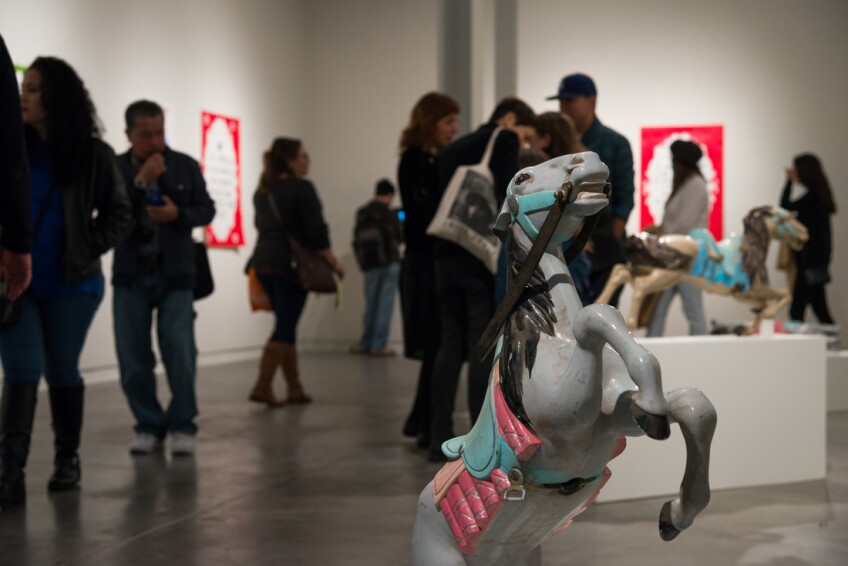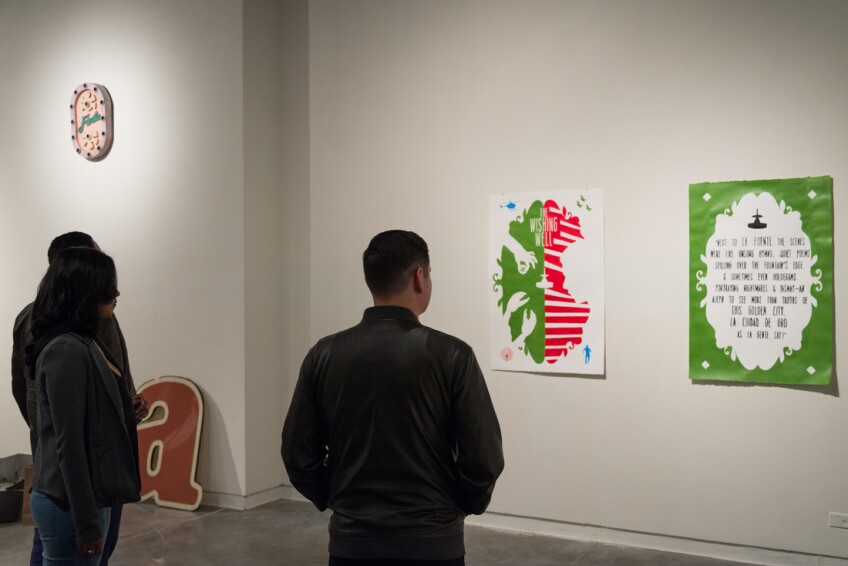Sarah Rafael García Captures Santa Ana’s History and Gentrification Through Fairy Tales

“You can't go home again,” wrote novelist Thomas Wolfe. Yet for writer Sarah Rafael García, home will always be Santa Ana, Calif., a city infused with memories of growing up in an extended Mexican-American community, and the place that she unexpectedly left at a young age.
Since leaving her hometown nearly three decades ago, García has returned periodically, often witnessing attempts by developers to gentrify the city. In 2016, she went home again, this time as artist-in-residence at Cal State Fullerton’s Grand Central Art Center in the Artists Village — where she became a modern-day Brother Grimm, transforming the community’s stories into fairy tale format. A multimedia installation based on her Santa Ana fairy tales was on view at Grand Central Art Center in Santa Ana in May 2017.

Fairy tales may be a relatively new approach for García, but writing has been a fixture in her life, ever since her father died unexpectedly of an aneurysm in 1988 when she was just 14. At the time she, her Mexican immigrant parents and her sisters, Suzanne and Nydia, were living in Santa Ana. García describes the city as, “the largest border town without a border, with its 80 percent Mexican-American population.” Here, the writer became steeped in the joys and race-inflicted sorrows that come with living in such a community. Issues like gang violence and gentrification weren’t just headlines, but were reality living outside her window. “Growing up in Santa Ana, California was quite a unique experience for us… As children, we were very oblivious to the nearby ‘hooker’ boulevard and the teenage boys smoking pot in the ditch located behind our backyard,” she writes in her 2008 book, “Las Niñas: A Collection of Childhood Memories.”
After her father’s death, her mother Sara received a life insurance settlement and moved the family to the mostly white community of Rancho Santa Margarita. They relocated there so that García and her sisters could attend better schools, her mother asserted. Yet this move became a culture shock for the girl of color who was surrounded by perfect blonde classmates, one of whom appeared on the program, Baywatch. Her grades dropped dramatically and she was transferred to an alternative school. All the while, she was secretly dating a gang member in Santa Ana.
During her four years in south Orange County, she longed for her hometown—and the desire to return there germinated within her for decades. Last year, she began transforming her childhood memories and desires into fairy tales, albeit those out of Grimm, not Disney. Reaching this epiphany followed decades of study, moving many times, extensive travel and a variety of jobs.

García’s nomadic life began when she moved out of her home right after high school—against her family’s wishes — to live on her own and attend Irvine Valley College. At IVC, she studied creative writing, sociology and Spanish, while paying her own tuition. “I didn’t even have a computer and there were semesters when I took classes without purchasing the required books. I wonder how I survived it all,” recalls García. Through her fierce determination, she transferred to Texas State University in Austin where she received financial aid while working full-time at a center for at-risk youth. After graduating in 1998 with a sociology degree, she worked in high-end marketing jobs in Los Angeles (one with a window overlooking the Hollywood sign), pursuing what she thought was the American dream. That dream turned into a nightmare in 2004, when a mentally ill neighbor began stalking her. Unable to resolve this problem, she fled L.A. for a job teaching English in Beijing, China. She lived and worked there for 18 months.
More on local histories
During her stay there, she began composing stories of her family life in Santa Ana. By 2006, she had completed 20 stories, relating poignant experiences of cultural immersion; she compiled them into “Las Niñas.” She then left China, and worked in California’s wine country for two years, while researching an appropriate publisher for her book.
She returned to Santa Ana in 2008, discovering to her dismay that the place was drastically changed with its galleries, upscale shops, restaurants and apartments. Only the carousel in front of the landmark Yost Theater remained — a nostalgic anchor — as she pursued her journey in life. That journey included working at tutoring jobs, promoting her book, and giving back to her community by starting the non-profit Barrio Writers (BW) program. BW counsels teens from underserved communities through spontaneous reading, grammar, creative writing, higher education and cultural arts. The program now has eight chapters in California and Texas.

García moved to Austin, Texas in 2010. Two years later, she returned to Texas State for graduate studies. While participating in the university’s study abroad program, which placed her in Ireland, she discovered the power of the fairy tale format. “Ireland made me realize that I could use another form to tell my stories, a form people around the world are familiar with and that are also part of pop culture,” she writes in the Los Angeles-based Latino blog, La Bloga. “Fairy tales and fables are classic styles used time and time again, so I started writing feminist short stories incorporating some of the characteristics of fairy tales and fables in order to offer a counter narrative to female narratives, as a way to turn the male gaze back on society, making society accountable for sculpting our stereotypes.” She received her MFA in creative writing from Texas State in 2015.
García soon started writing a new collection of fairy tales, inspired by her Santa Ana childhood memories. She crafted a proposal based on these stories in a bid to become artist-in-residence at Grand Central Art Center, which caught the eye of its director John Spiak. “It was wonderful to see Sarah’s stories written from the perspective of someone who spent her youth in this city,” he says. “Her innovative approach shares community histories, past and present.” Her proposal won her a one-year arts residency at the Center, where she lives what she calls a “fairy goddess” life. Without having to worry about paying the rent or utilities, she gained the peace of mind to concentrate on her stories of Santa Ana.
There are six stories in “SanTana’s Fairy Tales” (in English and Spanish). These include “The Carousel’s Lullaby,” expressing longing for the carousel, which was put into storage in 2011. She also tells cautionary tales about what might occur in Santa Ana with the threat of deportation. In “Hector & Graciela,” she writes, “Police held heavy batons, threatening gente (people) to return where they came from, while piercing sirens foreshadowed an immigrant’s worse nightmare.”
Using words to paint pictures, García is chronicling in “SanTana’s Fairy Tales” the land that was once filled with a vibrant culture. “Where once Mexican culture was celebrated on Calle Cuatro, she explains, “today white-walled coffee shops and trendy barbers are replacing quinceañera stores and chasing away fruteros (fruit vendors).”
In the story “The Wishing Well,” García also describes her own experience as a writer: “So on this new day when La Fuente [fountain] flowed water again, she knew what was to come, it was up to her to separate the realities from the golden city’s past lives, she knew she had to write it all down to let la gente decide what is true.” Spiak remarks: “Sarah brings an amazing energy and passion to her work. Her sense of community, deep connections and especially her writing project open greater dialogue.”
On April first, Grand Central exhibited an installation related to García’s fairy tales, along with a presentation by performance artists and Pacific Symphony members. The installation includes an oversized illustrated version of her book, large reproductions of its pages, and relics from the discarded carousel, including a horse and decorative components from its frame.

Today, García is working on a new project, a novella with political overtones. She explains: “The sci-fi historical novella revolves around five Mexican women post WWII/Bracero Era, who create a collective voice through chisme (gossip) while also breaking gender roles, sharing border crossing experiences and building community. The alternate reality traces a granddaughter and her women-of-color comadres (close women friends) in present post-Trump time, confronting current social justice movements, politics, gender roles and academia!” A publisher is considering the novella, which will be dedicated to her grandmothers; she is determined to debut it in 2018.
As a Latina artist herself who has long admired Mexican artist Frida Kahlo, García visited Santa Ana’s Bowers Museum in April 2017 to view its “Frida Kahlo: Her Photos” exhibition. “I realize as women we forget to celebrate our life journeys simply because we are still navigating through them,” she remarked, “and sometimes we forget to look back. How many times have we thought, I wonder if Frida ever knew that this would be her life now?”
Top image: Remnants of the old carousel at Yost Theater at "SanTana's Fairy Tales". Photo by Chris Wormald.




